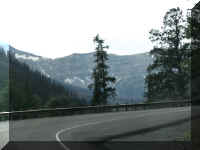
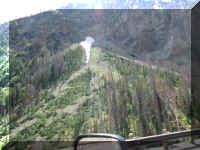
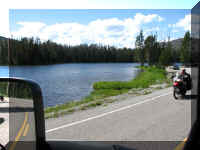
Yellowstone National Park - 2008 . . .
on our
route to the Pacific Northwest
Updated: 01/05/09
Yellowstone was the world's first National Park, established by Congress in 1872. Today, it is a Biosphere Reserve and World Heritage Site. It comprises 3,472 square miles, most of which are in Wyoming. It also extends into Montana and Idaho.
The most outstanding natural features are the thousands of geysers that compose the world's largest thermal basins. Some bursts of scalding water spurt high into the air, while others bubble and spit in murky depths of the geysers.
Yellowstone is the most successful wildlife sanctuary in the world.
Our plan was to see as much of Yellowstone as we wanted to see. We think we accomplished this and enjoyed every minute of our stay. We had four beautiful, mostly sunny days with temperatures below 80 degrees. We avoided the Fishing Bridge area of the park due to the actively burning forest fires. The smoke made it unpleasant and not good for Mary Lou's breathing.
A word of caution to our RVing friends. During the summer tourist season, a "RV" parking spot at any attraction will not be available for you to park a trailer, fifth wheel or large motorhome. The people driving cars will park wherever there is a spot - they will not respect "RV Only" signs. So, as you probably do anyway, park your RV at the campground and visit the attractions with your tow vehicle or "towed" vehicle.
This page is organized roughly in the order we saw the various attractions. We will try to limit our words because a lot of words are not necessary. We hope our photographs adequately depict the beauty of the park. Hopefully, you will not tire of our use of the word 'beautiful'.
So, lets get started.
We entered the park at the East Entrance. Fortunately for us, the wind was blowing the forest fire smoke away from us so we could enjoy beautiful views on our drive in.

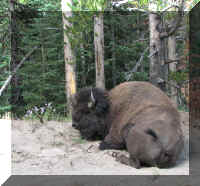 This little guy got tired of walking and laid down beside the road
to rest. He was a traffic stopper.
This little guy got tired of walking and laid down beside the road
to rest. He was a traffic stopper.
A herd of buffalo drew a lot of attention . . .
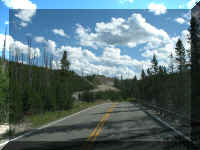
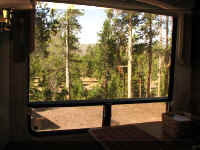
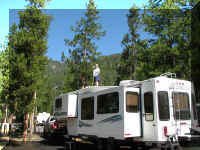
Just up the road from our campground,
Gibbon Falls . . .
Beryl Spring . . .
Artists Paintpots . . .
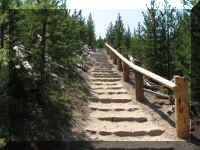
A digital camera's processing delay made catching the sprits a challenge.
Mud pots are acidic hot springs with a limited water supply. Various gasses escape through the wet clay mud and cause it to bubble and 'stink' like rotten eggs.
Our truck is way down there. Workers adding a loop to the walkway.
Norris Geyser Basin . . .
This was a huge attraction. You could walk miles here.
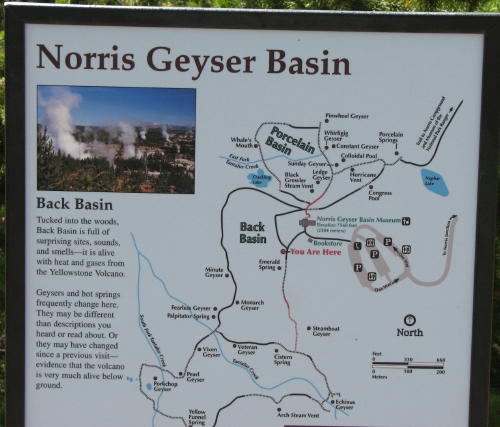
How deep and clear. . .
Lunch was next . . .

All of a sudden, to Fred's surprise, Mary Lou is saying, "no, you aren't getting any of my lunch". She was talking to a bird that was begging. When that failed, the bird begged from Fred. Then back to it's perch to try Mary Lou again. The first bird was joined by a second to no avail.
On the road . . .
One little loop road was just an opportunity to drive between rocks.
Mammoth Hot Spring Area . . .
Near the parks north entrance, the springs are characterized by terrace-like formations created by limestone deposits. Some are quite colorful, others are white from the mineral deposits.
Gardiner, Montana . . .
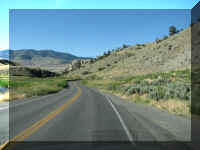
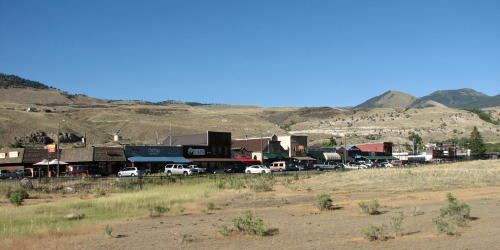
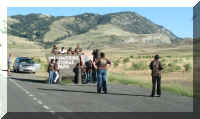 Other
than animals, there is nothing that draws a crowd like the entrance sign to a
national park. Knowing this, many not in the pull-off have sidewalks leading to them
to make it convenient for group photographs.
Other
than animals, there is nothing that draws a crowd like the entrance sign to a
national park. Knowing this, many not in the pull-off have sidewalks leading to them
to make it convenient for group photographs.
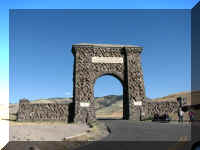
Back in Wyoming . . .
On the way back from Gardiner, we encountered these two pronghorns on a hillside. One went down to the stream for a drink and eat some of a bush. The other one was skittish and retreated higher on the hill.
Mammoth Hot Springs . . .
We returned through this area on our way back to camp.
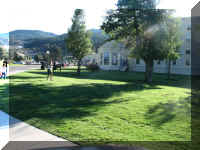
Mom and baby drifted off by themselves to trim the bushes.
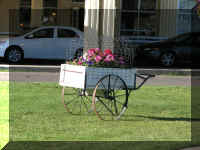
Along the road . . .
A mule deer feeding
Firehole Canyon Drive and Firehole Falls . . .
A chipmunk . . .
We happened on to this swimming area. We didn't know about it, but lots of other people did. The National Park Service discourages swimming in the parks lakes, streams and rivers. Someplace Mary Lou saw a warning that the waters in Yellowstone are extremely cold and to use caution when swimming in them.
Fountain Flat Drive . . .
We walked out to see the bubbling spring at the rivers edge. The hot water spilled directly into the river.
Mary Lou spotted these children playing
on the fallen trees. She
overheard one parent suggest they take out the jungle
gym
at home and put in some dead trees.
Fountain Paint Pot . . .
These pots just bubble and bubble . . . then all of a sudden there is a shot into the air. The pots are actually large springs filled with hot clay ranging in color from white to shades of pink and black.
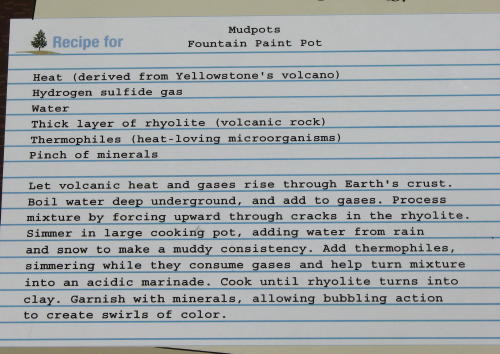
Great Fountain Geyser . . .
We could have stood here for hours watching this geyser, it erupted frequently and each time was a little different. For activity it was much more entertaining that Old Faithful, but didn't have the dramatic height.
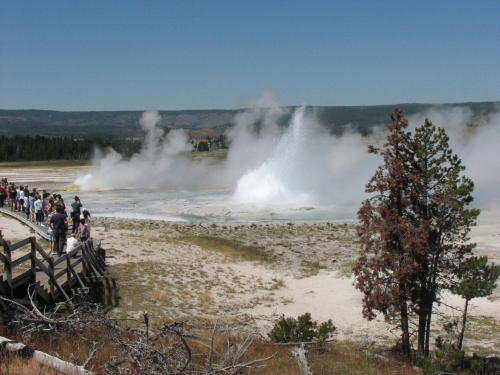
This little geyser was active when the larger ones were quiet.
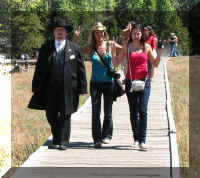 When leaving the geyser area, a group from a tour bus was walking in.
Fred told him he had to photograph anybody dressed like the town Marshall. He
was the a tour leader.
When leaving the geyser area, a group from a tour bus was walking in.
Fred told him he had to photograph anybody dressed like the town Marshall. He
was the a tour leader.
The gals were disappointed that Fred wasn't photographing them.
Midway Geyser Basin . . .
The colors here were fantastic.
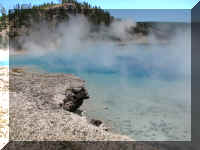
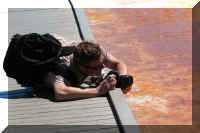 Lets
see, is this the composition I want?
Lets
see, is this the composition I want?
The wind was blowing very hard at this location. If you were wearing headgear, you had to hold it on, tie it on your head or carry it in your hand. A ranger told Fred that they will eventually burn up or dissolve. No one will attempt to retrieve them with a pole or any other way.
Old Faithful Geyser. . .
We visited Old Faithful twice. The 'waiting period' is about 90 minutes, We spent almost that amount that time walking through the lodge and doing e-mails. We decided to return for another eruption.
Both times, there were a few other people waiting as well. Old Faithful isn't totally dependable - it is +or - ten minute to the expected schedule. So, the waiting game is played.
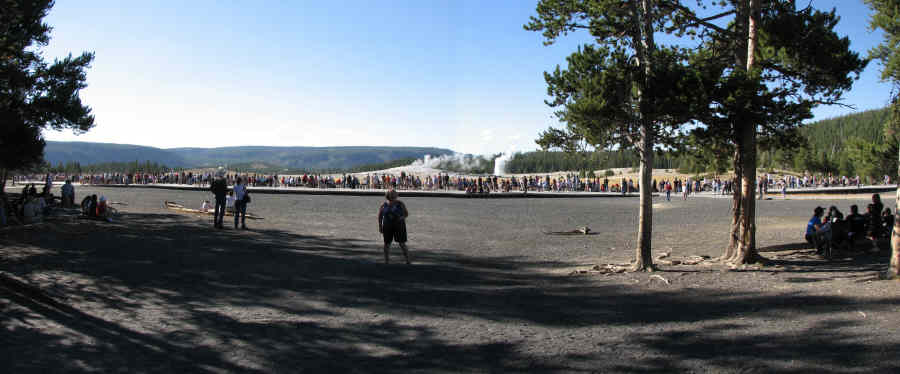
First Visit Second Visit
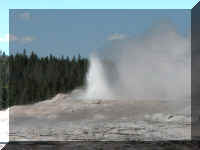
The Old Faithful Inn, a National Historic Landmark, was built of local logs and stone in the winter of 1903-1904, adjacent to its namesake geyser. It has undergone a three-year renovation. Because the Inn sits in one of the Country's most active seismic zones, it has been fitted with new structural steel components providing additional strength and resilience to the structure. They are encased the wood/log sleeves to blend with the historic features. Mary Lou looked to see if she could find any of them, but could not.
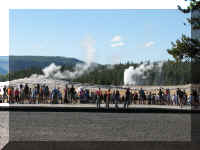
West Thumb Geyser Basin . . .
Black Pool
Abyss Pool
We had dinner at the Lake House Restaurant in Grant Village. The sunset was nice, the experience was not - the walk, the food, the service.
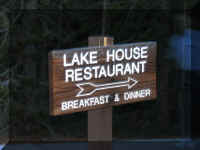
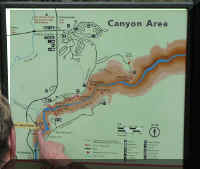 The
area near Canyon Village was very popular. Parking was at a premium but worth
it, especially at the canyon. Added to that, there were road closures due to
construction, so we could not visit all of the viewing areas.
The
area near Canyon Village was very popular. Parking was at a premium but worth
it, especially at the canyon. Added to that, there were road closures due to
construction, so we could not visit all of the viewing areas.
The Brink of the Falls . . .
The Upper Falls of the Yellowstone River . . .
The Grand Canyon of Yellowstone . . .

The ride to the Tower- Roosevelt area . . .
Fred made a photograph from here but saw no bear.
Tower Fall . . .
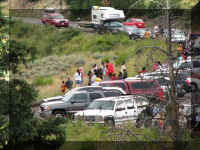
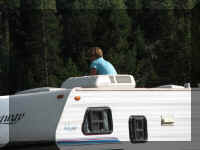
Of course, we photographed the bear and her cub.
Towers Falls
Mount Washburn . . .
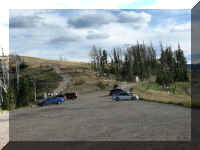
Elevation on the TOP is 10,243 feet.
The cell reception was very good.
The view from Mount Washburn . . .
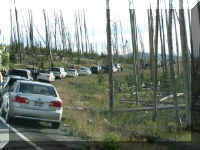
When we got to the bottom there was a traffic jam.
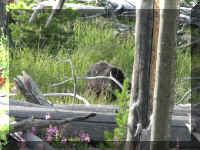
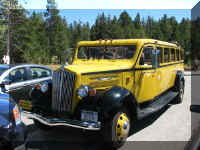
There is much to see and do in Yellowstone. Our stay in the park was four days. We chose to drive, and take limited hikes to see the attractions. However, there are numerous hiking trails of various lengths for those physically able.
Entrance fees to the park vary. Entrance passes are good for seven consecutive days in both Yellowstone and Grand Teton national parks. For 2008-2009, private, non-commercial vehicles are $25 each. There are many special passes available that may waive the fee. Fred, as a holder of a Golden Age Pass, got us in free.
GO BACK TO > > > Pacific Northwest - 2008